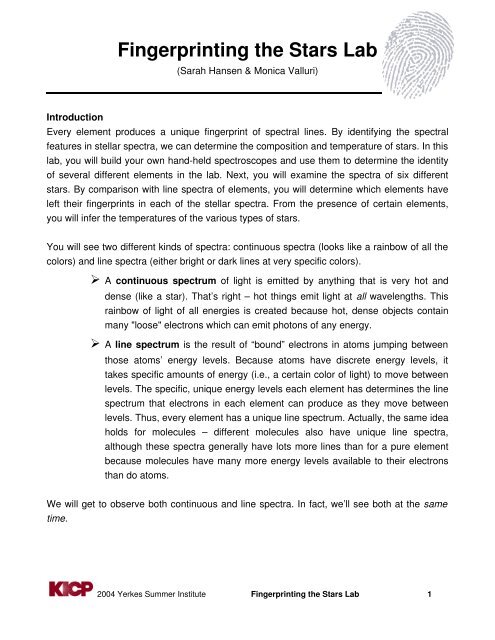Fingerprinting the Stars Lab
Fingerprinting the Stars Lab
Fingerprinting the Stars Lab
You also want an ePaper? Increase the reach of your titles
YUMPU automatically turns print PDFs into web optimized ePapers that Google loves.
<strong>Fingerprinting</strong> <strong>the</strong> <strong>Stars</strong> <strong>Lab</strong>(Sarah Hansen & Monica Valluri)IntroductionEvery element produces a unique fingerprint of spectral lines. By identifying <strong>the</strong> spectralfeatures in stellar spectra, we can determine <strong>the</strong> composition and temperature of stars. In thislab, you will build your own handheld spectroscopes and use <strong>the</strong>m to determine <strong>the</strong> identityof several different elements in <strong>the</strong> lab. Next, you will examine <strong>the</strong> spectra of six differentstars. By comparison with line spectra of elements, you will determine which elements haveleft <strong>the</strong>ir fingerprints in each of <strong>the</strong> stellar spectra. From <strong>the</strong> presence of certain elements,you will infer <strong>the</strong> temperatures of <strong>the</strong> various types of stars.You will see two different kinds of spectra: continuous spectra (looks like a rainbow of all <strong>the</strong>colors) and line spectra (ei<strong>the</strong>r bright or dark lines at very specific colors). A continuous spectrum of light is emitted by anything that is very hot anddense (like a star). That’s right – hot things emit light at all wavelengths. Thisrainbow of light of all energies is created because hot, dense objects containmany "loose" electrons which can emit photons of any energy. A line spectrum is <strong>the</strong> result of “bound” electrons in atoms jumping betweenthose atoms’ energy levels. Because atoms have discrete energy levels, ittakes specific amounts of energy (i.e., a certain color of light) to move betweenlevels. The specific, unique energy levels each element has determines <strong>the</strong> linespectrum that electrons in each element can produce as <strong>the</strong>y move betweenlevels. Thus, every element has a unique line spectrum. Actually, <strong>the</strong> same ideaholds for molecules – different molecules also have unique line spectra,although <strong>the</strong>se spectra generally have lots more lines than for a pure elementbecause molecules have many more energy levels available to <strong>the</strong>ir electronsthan do atoms.We will get to observe both continuous and line spectra. In fact, we’ll see both at <strong>the</strong> sametime.2004 Yerkes Summer Institute <strong>Fingerprinting</strong> <strong>the</strong> <strong>Stars</strong> <strong>Lab</strong> 1
Part I: Build Your Own SpectroscopeIn this part of <strong>the</strong> lab, you will cut out and assemble a spectroscope. Whenyou look through <strong>the</strong> spectroscope at a bright light, you will see <strong>the</strong>spectrum of light being emitted spread out inside <strong>the</strong> spectroscope. Thespectroscope has a printed wavelength scale so you can identify particularspectral lines by noting <strong>the</strong> wavelengths where <strong>the</strong> <strong>the</strong>y are located.What You Need:1 Spectroscope Poster1 grating1 pair of scissorsTapeWhat To Do:On one side of <strong>the</strong> poster are step by step directions for making your spectroscope. Follow<strong>the</strong>se directions carefully and you will make a fun and useful tool!Note: It can be interesting to look at <strong>the</strong> spectra produced by <strong>the</strong> lights in <strong>the</strong> room,streetlights, clouds, <strong>the</strong> TV, etc. Feel free to use <strong>the</strong> spectroscope to observe <strong>the</strong> worldaround you, but remember:NEVER LOOK DIRECTLY AT THE SUN!!2004 Yerkes Summer Institute <strong>Fingerprinting</strong> <strong>the</strong> <strong>Stars</strong> <strong>Lab</strong> 2
Part II: Elementary IdentificationNow you will use your spectroscope to identify different elements. In stars,<strong>the</strong>re are spectral lines from many different elements and molecules. Inorder to recognize which lines are parts of <strong>the</strong> patterns of various elements,you will now get a chance to view <strong>the</strong> light emitted by pure samples ofdifferent elements. This way, you can learn each element on its own, before having to sortout several elements all at once in <strong>the</strong> spectrum of a star. Should be easy, right – just lookthrough your spectroscope at a sample of an element….But <strong>the</strong>re’s a catch: it isn’t easy to make an element (or molecular compound) show itsfingerprint of spectral lines. You have to supply enough energy for <strong>the</strong> atom’s electrons tobegin jumping around and showing off <strong>the</strong> line spectrum of <strong>the</strong> element. There are two waysto give <strong>the</strong> electrons enough energy to show a line spectrum:or• Heat <strong>the</strong> substance to a certain temperature range. Only certain temperatureswill do – too hot or too cool and <strong>the</strong> element won’t show itself. <strong>Stars</strong> get to <strong>the</strong> righttemperatures (many 1000’s of degrees) for <strong>the</strong> electrons in atoms and molecules tomake <strong>the</strong>ir signature line spectra.• Send a certain amount of electrical current through <strong>the</strong> substance. Since wecan’t easily heat anything hot enough to produce a line spectrum, in <strong>the</strong> lab we usespecial lamps that send a strong current through a sample of a pure element,triggering it to emit its signature line spectrum.The equipment we use to send a current through a gaseous element is called a dischargelamp. A glass tube filled with gas (called a discharge tube) fits into <strong>the</strong> lamp. When <strong>the</strong> lampis turned on, a current passes through <strong>the</strong> tube, exciting <strong>the</strong> electrons in <strong>the</strong> atoms within,thus causing <strong>the</strong> tube of gas to glow brilliantly. You can <strong>the</strong>n use your spectroscope toobserve <strong>the</strong> line spectrum being emitted by <strong>the</strong> element.2004 Yerkes Summer Institute <strong>Fingerprinting</strong> <strong>the</strong> <strong>Stars</strong> <strong>Lab</strong> 3
Your challenge is to correctly ID eight unknown elements bycomparing <strong>the</strong>ir spectra with a chart showing <strong>the</strong> spectra of manydifferent elements.What You Need:Your spectroscope2 sheets of “Elemental IDs” paperPencil or penWhat To Do:Tape <strong>the</strong> two “Elemental IDs” sheets into consecutive pages in your lab notebook.For each discharge tube:1. Pick a discharge lamp to study, and record <strong>the</strong> number of <strong>the</strong> lamp on a blank IDchart.2. Look through your spectroscope at <strong>the</strong> glowing discharge tube. It may take practice toget <strong>the</strong> spectroscope lined up right so that you can see <strong>the</strong> line spectrum produced by<strong>the</strong> gas in <strong>the</strong> tube. If you are having a lot of difficulty seeing <strong>the</strong> spectrum, ask yourlab instructor for help.3. Sketch what you see in <strong>the</strong> spectrometer on <strong>the</strong> ID chart for that lamp.4. <strong>Lab</strong>el each line with <strong>the</strong> color that it appears, and note in <strong>the</strong> margin which lines areespecially bright and which are weak. Some lines may be quite faint and hard to see.Compare your ID charts to <strong>the</strong> chart of emission lines in <strong>the</strong> classroom. By comparing <strong>the</strong>pattern of lines you observed with <strong>the</strong> classroom chart, you should be able to identify <strong>the</strong>contents of all <strong>the</strong> discharge tubes. <strong>Lab</strong>el each of your ID charts with <strong>the</strong> element you have determined it to be.Congratulations! You now know how to fingerprint <strong>the</strong> elements. Time to put those skills towork…2004 Yerkes Summer Institute <strong>Fingerprinting</strong> <strong>the</strong> <strong>Stars</strong> <strong>Lab</strong> 4
Part III: What’s in <strong>the</strong> <strong>Stars</strong>?Your goal for this part of <strong>the</strong> lab is to determine what elements are showing<strong>the</strong>ir fingerprints in different stars. To do so, you will compare <strong>the</strong> absorptionlines in real stellar spectra to <strong>the</strong> spectra of different elements andcompounds to find which elements/compounds have lines that match thosein <strong>the</strong> stellar spectra.What You Need:1 pack of stellar spectra1 pack of atomic/molecular spectra1 “<strong>Fingerprinting</strong> <strong>the</strong> <strong>Stars</strong>” WorksheetWhat To Do:Tape <strong>the</strong> worksheet into your lab notebook.For each stellar spectrum,1. Record <strong>the</strong> star’s name on <strong>the</strong> worksheet.2. Choose an atomic/molecular spectrum to compare to <strong>the</strong> stellar spectrum.3. Carefully align <strong>the</strong> two spectra you are comparing. Make sure <strong>the</strong> blue end of <strong>the</strong>stellar spectrum aligns with <strong>the</strong> 400.0 nm mark on <strong>the</strong> atomic/molecular spectrum,and that <strong>the</strong> red end of <strong>the</strong> stellar spectrum aligns with <strong>the</strong> 700.0 nm mark.4. Compare <strong>the</strong> two spectra. Are <strong>the</strong>re dark lines in <strong>the</strong> stellar spectrum where <strong>the</strong>re are dark lines in <strong>the</strong>atomic/molecular spectrum? If yes, <strong>the</strong>n that substance is showing itsfingerprint! If no, <strong>the</strong>n ei<strong>the</strong>r that substance is not present in <strong>the</strong> star you arestudying, or <strong>the</strong> star is not <strong>the</strong> right temperature to make thatelement/compound show its spectral lines.5. If <strong>the</strong> atomic/molecular lines are present in <strong>the</strong> stellar spectrum, record thatelement or compound on <strong>the</strong> worksheet in <strong>the</strong> “Substances Present in This Star”column.6. Repeat steps 25 for every atomic/molecular spectrum.2004 Yerkes Summer Institute <strong>Fingerprinting</strong> <strong>the</strong> <strong>Stars</strong> <strong>Lab</strong> 5
Part IV: Stellar TemperaturesNow that you know which elements are showing <strong>the</strong>ir fingerprint spectra ineach star, you can use that information to determine <strong>the</strong> temperature of allthose stars. Recall that different elements have to be heated to differenttemperatures to get <strong>the</strong>m to show <strong>the</strong>ir spectral fingerprints. So when yousee <strong>the</strong> spectrum of an element, you can make a good guess at <strong>the</strong> temperature. Withseveral elements present, you can refine your temperature estimate.What To Do:For each star:1. Using <strong>the</strong> table of temperatures in <strong>the</strong> classroom, find <strong>the</strong> temperature range that isright for producing line spectra of each substance you identified in <strong>the</strong> stellar spectra.? Record <strong>the</strong> appropriate temperature range next to each identified substance in<strong>the</strong> “Substance Temp Range” column.2. Examine <strong>the</strong> temperature ranges you have listed. Do <strong>the</strong>y make sense?Example: Something is wrong if in <strong>the</strong> same star you think you saw an elementalspectrum that is produced only below 5000° and an elemental spectrum that isonly produced above 30,000°. The star cannot be both cooler than 5000° andhotter than 30,000°.If <strong>the</strong> temperatures seem ok, go on to <strong>the</strong> next step. If <strong>the</strong> temperatures you find donot make sense, take ano<strong>the</strong>r look at <strong>the</strong> spectrum and see if you misidentified somespectral lines.3. Determine a temperature range for <strong>the</strong> star that works for all <strong>the</strong> atomic/molecularspectra you see in that star.Example: If you see an atom that produces a line spectrum only in <strong>the</strong> temperaturerange 2000° 3500°, and also see a molecule that produces a line spectrum in <strong>the</strong>temperature range 3000° 4500°, <strong>the</strong>n <strong>the</strong> star must be between and 3000° and3500° to make both substances produce line spectra. Record your estimate of stellar temperature on <strong>the</strong> worksheet.2004 Yerkes Summer Institute <strong>Fingerprinting</strong> <strong>the</strong> <strong>Stars</strong> <strong>Lab</strong> 6
Elemental IDsElement #_______This element is:_____________________Element #_______This element is:_____________________Element #_______This element is:_____________________Element #_______This element is:_____________________2004 Yerkes Summer Institute <strong>Fingerprinting</strong> <strong>the</strong> <strong>Stars</strong> <strong>Lab</strong> 7
<strong>Fingerprinting</strong> <strong>the</strong> <strong>Stars</strong>Star NameSubstances Present in ThisSubstance Temp RangeStellar TemperatureStar1.___________________________________________2.____________________________________________3.____________________________________________1.____________________________________________2.____________________________________________3.____________________________________________1.____________________________________________2.____________________________________________3.____________________________________________1.____________________________________________2.____________________________________________3.____________________________________________1.____________________________________________2.____________________________________________3.____________________________________________1.____________________________________________2.____________________________________________3.____________________________________________2004 Yerkes Summer Institute <strong>Fingerprinting</strong> <strong>the</strong> <strong>Stars</strong> <strong>Lab</strong> 8
















